What are the Mushrooms that Grow on Dead Trees in North Carolina or in the South?
Finding mushrooms that grow on dead trees in North Carolina or the South was not as easy as I thought. Some are mistaken for other mushrooms, some only show in certain seasons, and plenty of them don’t show appear often.
That’s why I created a list of the 10 Mushrooms that Grow on Dead Trees in North Carolina!
This ultimate guide will give you mushrooms that grow on dead trees in North Carolina or the south, how to identify them, and even where to find them.
***DISCLAIMER***
This article is intended to be for entertainment purposes only. There are similar-looking types of mushrooms that can be poisonous to humans and animals.
Do not use this as a guide to forage mushrooms. Do not use this as a guide to prepare, cook, and eat mushrooms.
You should work with your local mycological society, foraging experts, and local community clubs for identifying, foraging, and potentially eating mushrooms. In addition, you should never forage mushrooms on your own or use this guide to assist you in foraging mushrooms.
Read THIS Before Identifying Mushrooms that Grow on Dead Trees in North Carolina
Knowing the type of mushroom growing can be the difference between a fascinating hobby that can result in a nutritious and edible food source and a deadly toxin. Always make sure to work with your local city and gardening club before eating mushrooms found in the wild.
It is important to pay close attention to the following when picking or eliminating mushrooms:
- The size, including the cap, gills, scales, spores, and stem.
- The color, including the cap, gills, scales, spores, and stem.
- Location, both in the United States and in your yard
- Odor and even taste
And if you want to learn more about mushrooms that grow on dead trees watch the below video!
10 Mushrooms that Grow on Dead Trees in North Carolina
#1. Ringless Honey Mushroom (Armillaria Tabescens)
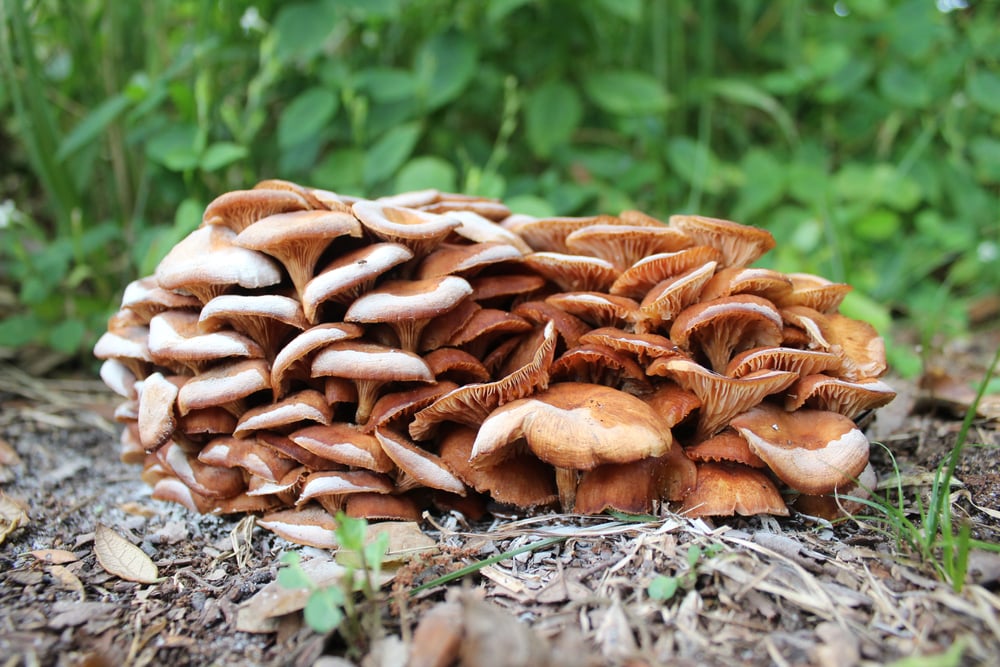

Specifications:
- The Ringless Honey Mushroom has a golden, honey-colored cap, white spores, narrow to broad pinkish/brown gills, and thick, cluster stalks.
- This type of mushroom grows from late summer to early winter throughout the United States, including North Carolina.
- It is important to kill these mushrooms when you see them as they will attack and kill trees by depleting them of water and nutrients. They are considered parasitic fungi.
- You can find the Ringless Honey Mushrooms in Oak Tree Stumps and Trunks in local parks.
- An interesting fact is that the ringless honey mushroom actually grows underneath the ground, rather than on top of it. The best way to get rid of this mushroom is from its roots beneath the ground!
#2. Field Mushroom (Agaricus campestris)
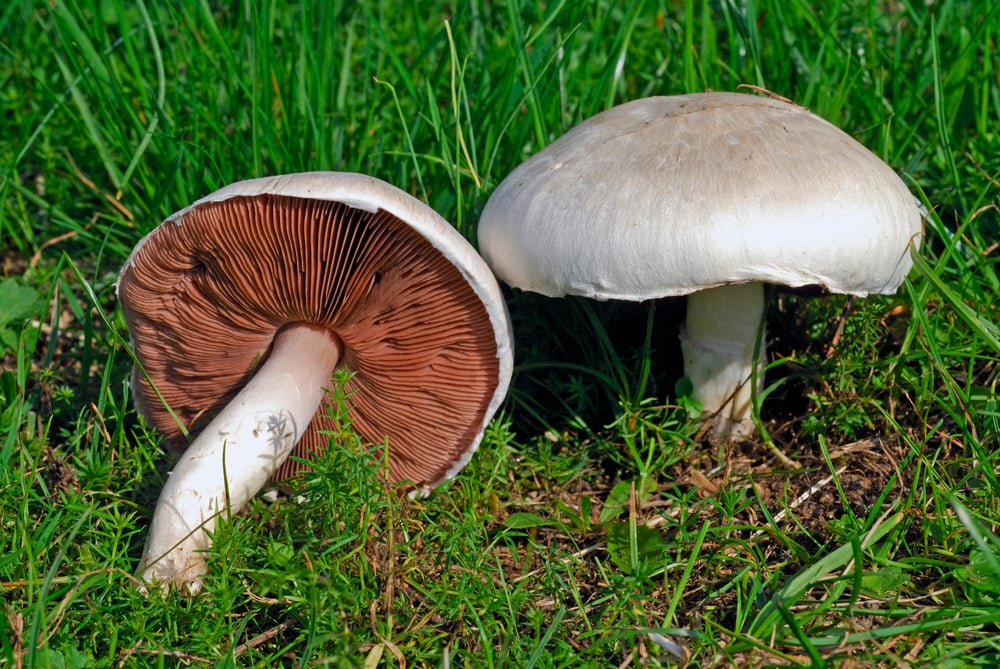

Specifications:
- The Field Mushroom has a white and pink cap, dark chocolate spores, narrow to broad white stalks that are brown, and deep pink and brown gills.
- This type of mushroom grows from late summer to early winter throughout the world, including North Carolina, Ireland, and Wales.
- You can leave these mushrooms. They grow on dead vegetation and will not kill trees, live plants, etc.
- The Field Mushroom can typically be found on dead vegetation, including grass, wood, and gardens throughout yards and parks in North Carolina.
- The Meadow Mushrooms sometimes can be confused for Field Mushrooms or other species due to their white gills and spores and therefore should not be foraged or eaten!
#3. Fly Agaric Mushrooms (Amanita muscaria)
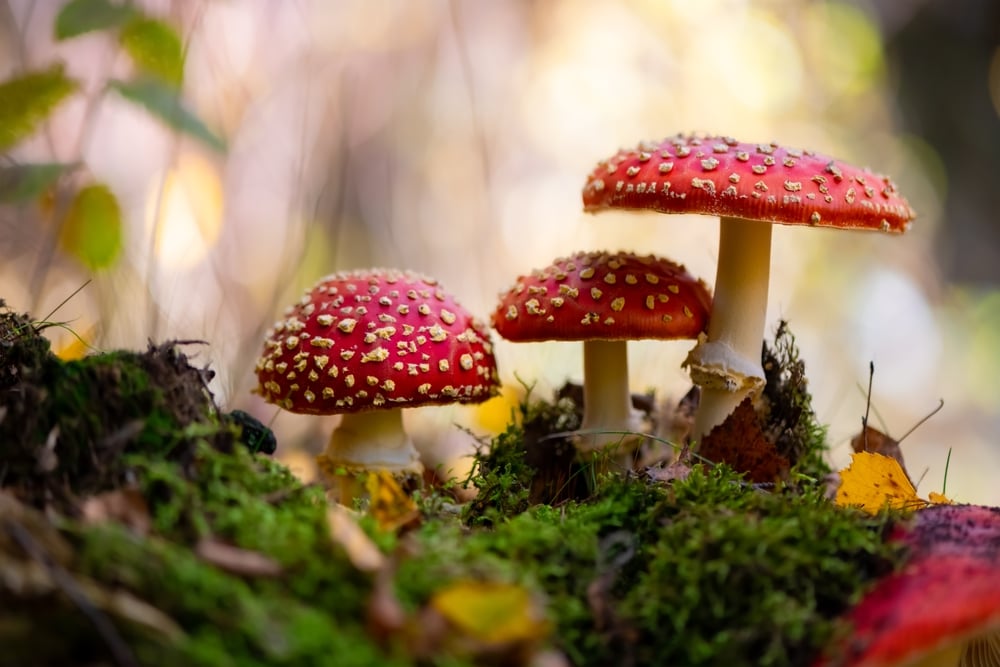

Specifications:
- The Fly Agaric Mushroom has a deep red and orange cap, white spores, narrow white stalks, and white to pale yellow gills.
- This type of mushroom grows from late summer to late fall throughout the world, including United States, Ireland, and Britain.
- You should kill these mushrooms unless you want them to be a natural pesticide or herbicide. This mushroom is common in North Carolina and will grow on hardwood, including spruce, birch, and pine trees. It also is a type of mushroom that has no smell!
- The Fly Agaric Mushroom is the type of mushroom you will typically see and read about in fairy tales and will even see in fairy gardens across the world. They are even found in books from the United States to Germany.
#4. Morels Mushrooms (Morchella esculenta)
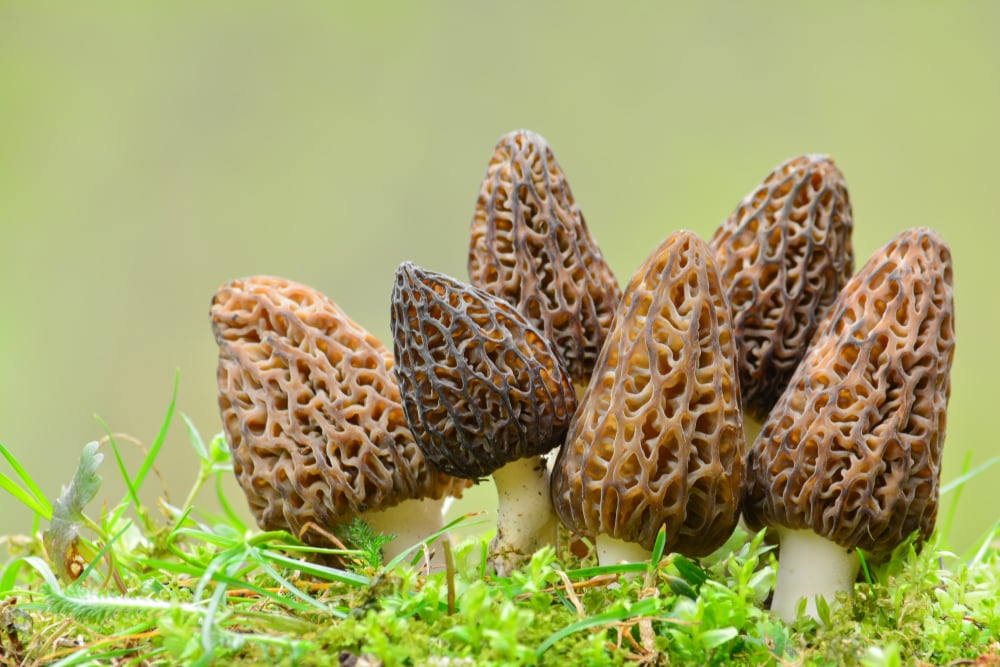

Specifications:
- The Morel Mushroom has a yellow and brown flesh orange cap, white spores, thick white or pale cream stalks, and brown gills.
- This type of mushroom grows from spring to early fall in the United States. While it can also be found in Ireland and Great Britain, it is much rarer. The Morel Mushroom is one of the most common mushrooms that can be found.
- You can leave the Morel Mushroom and even pick them up. This mushroom is considered symbiotic with its environment and can be found under dead trees and sometimes on trees. They are considered a beneficial partner with trees and insects won’t harm them either!
- Mushrooms can grow in all types of soil. The Morchella Esculenta though grows in chalky soil under dead trees throughout yards and parks.
- Did you know that the Morel Mushroom is one of the few mushrooms you can grow in your very own home?
#5. Shaggy Mane Mushroom (Coprinus comatus)
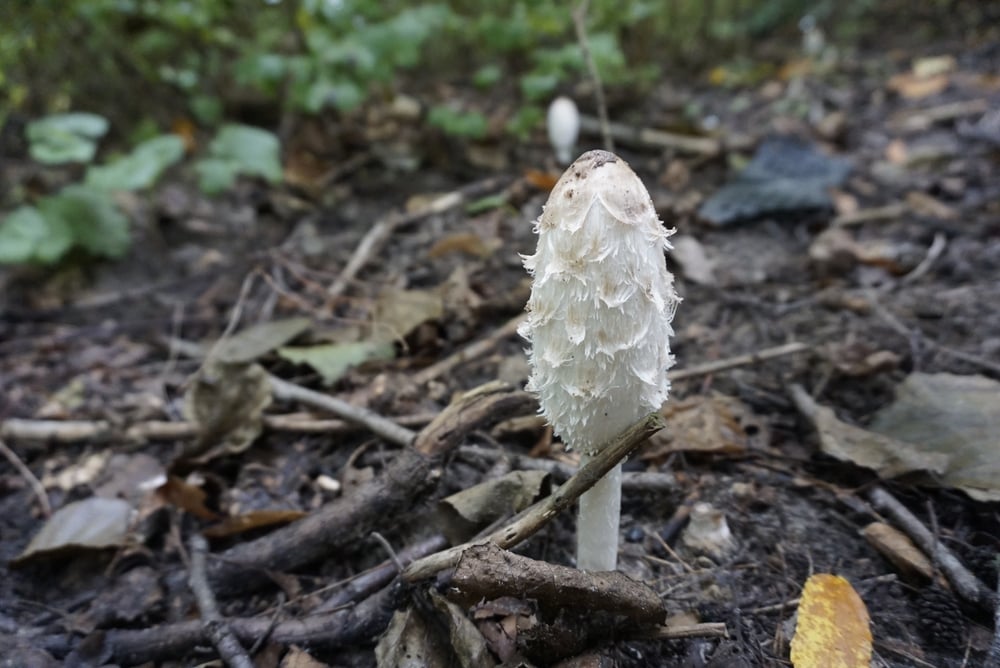

Specifications:
- The Shaggy Mane Mushroom has a white creamy cap, white spores, thin and tall stalks, and white gills.
- This type of mushroom grows on dead trees in the spring in the United States, Ireland, Britain, and Southern Europe. Wild animals will find this very delicious.
- The Shaggy Mane Mushroom can be found on grassy land and open woodlands.
- While this mushroom is enjoyed by wild animals, it is considered a parasitic mushroom that should be destroyed or foraged when seen.
#6. Jack O Lantern Mushroom (Omphalotus olearius)


Specifications:
- The Jack O Lantern Mushroom has an Orange and Yellow cap, white spores, thick, orange and dark yellow stalks, and dark orange gills.
- This type of mushroom grows from early fall to winter in the United States, Ireland, Britain, and Southern Europe. No one or no animal will typically consume this type of mushroom.
- The Jack O Lantern Mushroom can be found in North Carolina, the United States, and throughout Southern Europe. You will find it under dead trees in shaded areas, but should not be foraged.
- There are other types of similar mushroom species to the Jack O Lantern Mushroom that will grow in Europe and United States. Regardless of the specific type, they have similar characteristics and should be treated the same way.
#7. Milkcap Mushroom (Lactarius subdulcis)
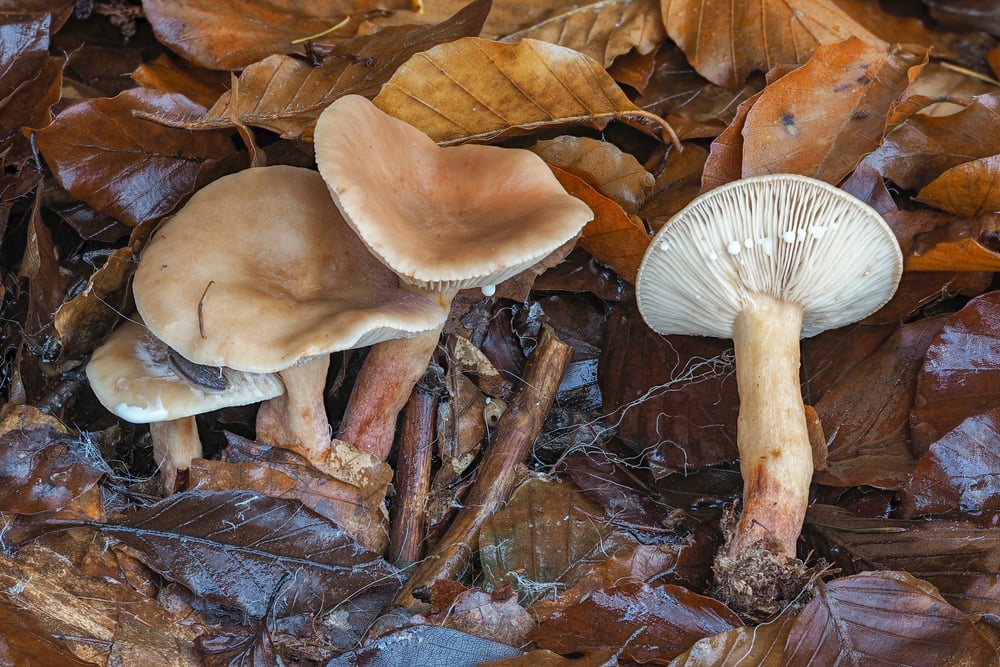

Specifications:
- The Milkcap Mushroom has a creamy white cap, white and brown spores, small and thin white cream stems, and white and brown gills.
- This type of mushroom grows on dead trees from summer to winter in the United States, Ireland, and Britain.
- The Milkcap Mushroom can be found in yards in North Carolina and the United States. You will find them under hardwood trees.
- When the Milkcap Mushroom gills and cap are cut you’ll notice a creamy-white liquid that gives the mushrooms its “sweet” taste for wild animals that eat it.
#8. Deadly Galerina Mushroom (Galerina marginata)
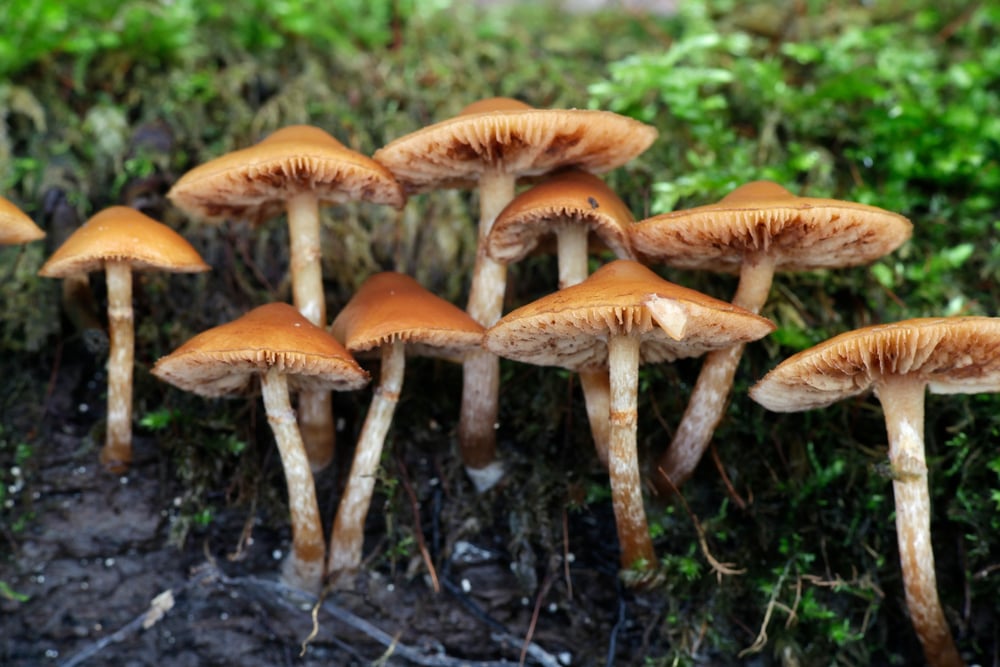

Specifications:
- The Funeral Bell Mushroom has a honey yellow and brown cap, brown spores, tall and thick brown stems, cream gills.
- This type of mushroom grows from summer to fall in the United States, Ireland, and Britain.
- The Funeral Bell Mushroom can be found in yards in North Carolina and the United States. You will find them in Stumps, Dead Trees, Broken Branches, and sometimes even dead leaves in the fall.
- It should be noted that even though the Funeral Bell Mushroom typically grows in the summer and fall in North Carolina, in some parts of the United States it can grow any time of the year! You cannot find it in local parks.
#9. Puffball Mushroom (Lycoperdon perlatum)
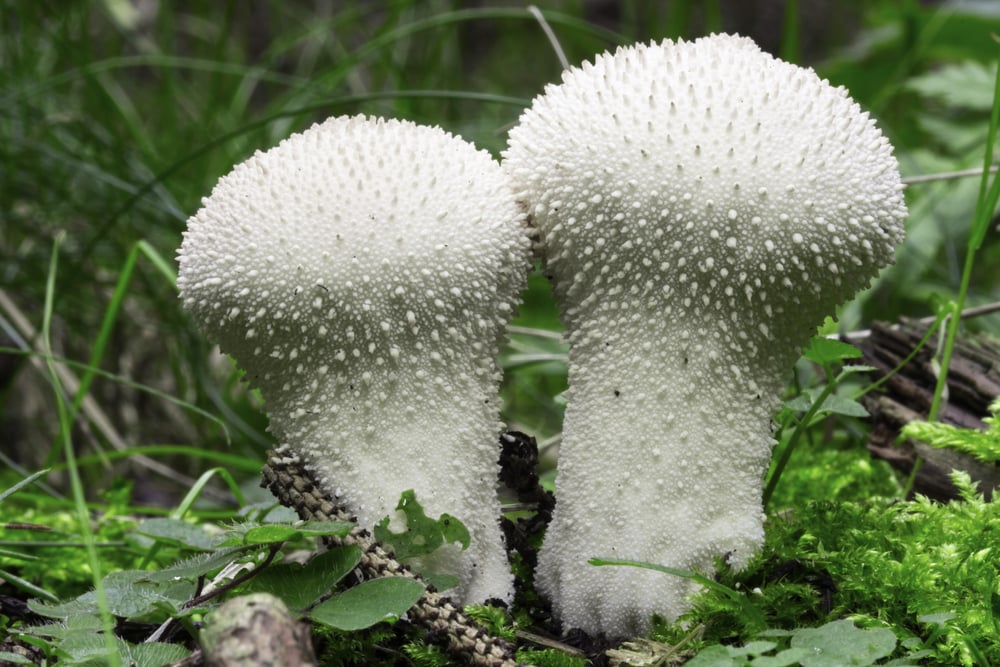

Specifications:
- The Puffball Mushroom has a white and cream cap, white spores, tall and thick white stems, and cream gills.
- This type of mushroom grows from summer to early winter in the United States, Ireland, and Britain.
- The Puffball Mushroom can be found in North Carolina and the United States. You will find them in woodlands, leaves, and even sandy areas.
- The Puffball Mushroom gets its name based on how it looks like a giant puffball when rain hits it or an animal or person rubs up against it!
#10. Wood Blewit (Lepista nuda)
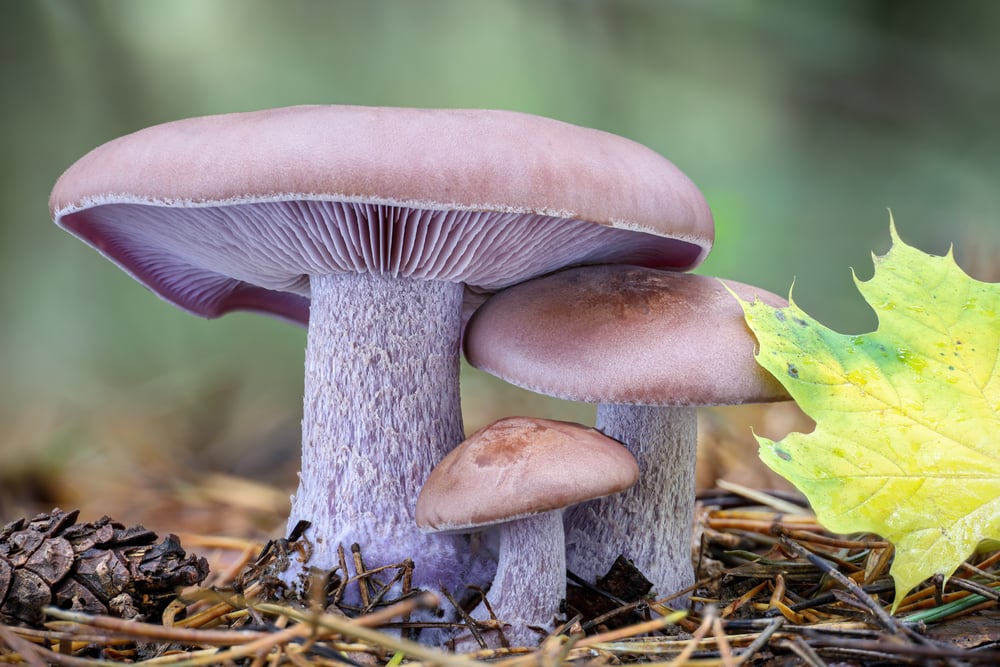

Specifications:
- The Wood Blewit Mushroom has a purple and cream cap, gray spores, tall and thick gray stems, and purple and cream gills.
- This type of mushroom grows from summer to winter in the United States, Ireland, and Britain.
- The Wood Blewit Mushroom can be found in mixed woodland yards in North Carolina and the United States. You will find them on dead trees and in compost.
- While other mushrooms have quickly been foraged and disappeared in North Carolina, the wood blewit mushroom continues to be plentiful and can be found throughout yards and forests.
Common Factors of Mushrooms that Grow on Dead Trees in North Carolina

As a reminder, the below factors are common for the mushrooms that grow on dead trees
- Most are parasitic to humans and should not be consumed.
- These mushrooms can be found throughout the state, but most commonly on dead trees and in wet areas.
- Each mushroom on this list has a common fungus relative that it can be mistaken for. Leverage your local mycological societies and experts before identifying common mushrooms.
- Most mushrooms on this list will only grow a maximum height of 6 inches tall and 3 or 4 inches wide.
- A majority of the mushrooms on this list will have no smell to them.
- The mushrooms on this will all have different colors of spores, caps, etc. This makes common mushrooms beautiful and a great hobby to get into.
And remember that you should pay attention to this guide, other local experts, and your local mushroom clubs before foraging. This can be the difference between a nutritious and delicious mushroom and a harmful and even deadly fungus.
If you want to learn about other mushrooms, chickens, vegetables, fruits, herbs, and bees check out thegardeningdad and search for the plant you want to grow in the upper right-hand corner.